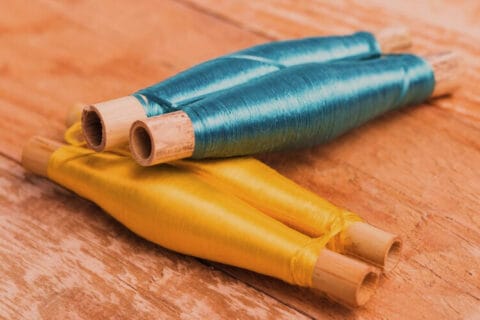Banarasi silk sarees are a symbol of luxury, elegance, and cultural heritage. Whether you’re searching for Kashi sarees online or browsing through Banarasi sarees at a local boutique, finding an authentic handwoven piece can sometimes be challenging. The rise of machine-made replicas has made it essential for buyers to know how to distinguish genuine Banarasi silk sarees from imitations. In this guide, we’ll take you through some crucial tips for identifying authentic Banarasi sarees and how to ensure you’re investing in a true masterpiece.
The Rich Tradition of Banarasi Silk Sarees
Banarasi sarees have been woven in Varanasi (also known as Kashi) for centuries, making them one of the most revered and sought-after sarees in India. From the intricate zari work to the luxurious feel of Katan silk and pure silk sarees, each Banarasi saree tells a story of India’s rich weaving tradition. However, with mass production and replicas flooding the market, it’s important to recognize the markers of a true handwoven Banarasi silk saree.
Key Features of Authentic Banarasi Silk Sarees
When buying a Banarasi saree, especially online, it’s essential to be armed with knowledge. Here’s how you can identify an authentic piece:
1. Examine the Fabric Quality
Genuine Banarasi silk sarees are made from pure silk, often Katan silk or soft silk, which gives them their characteristic smoothness and shine. To check for authenticity:
- Feel the fabric: Authentic Banarasi silk feels luxurious, soft, and has a natural sheen. Replicas often use cheaper materials that feel coarse or stiff.
- Lustre: Authentic silk sarees have a subtle glow, not an overly shiny or plastic-like appearance. The fabric will have a natural finish, which sets it apart from synthetic blends.
2. Check for Handwoven Details
One of the key characteristics of an authentic Banarasi saree is the detailed handwoven designs. Machine-made replicas might mimic the patterns, but they lack the finesse and intricate workmanship that comes from handweaving.
- Look for irregularities: Handmade sarees may have minor inconsistencies or tiny imperfections in the weave. This is a sign of the handloom process, while machine-made sarees tend to look too perfect.
- Feel the motifs: Handwoven motifs in Banarasi sarees are slightly raised and textured due to the intricate weaving process, while machine-made sarees often have flat designs.
3. Zari Work
Zari—the gold or silver threadwork—defines the richness of Banarasi sarees. Authentic Banarasi sarees use real zari, made from silver or gold-plated threads, which is a hallmark of traditional weaving.
- Check the zari: Real zari has a fine metallic finish and an antique charm. Machine-made sarees use plastic or metallic-coated threads, which are shinier but lack the elegance of real zari.
- Burn test: For the bold buyers, a small burn test on a loose thread of the saree can help verify if it’s real zari. Authentic zari leaves behind a black ash-like residue, while fake zari melts like plastic.
4. Weave Pattern: Look for Banarasi Signature Motifs
Authentic Banarasi sarees are known for their signature floral, leaf, and intricate jaal patterns. Common motifs include kalga, bel, and jhallar borders. These motifs have Mughal influences, which are difficult to replicate in mass production.
- Check the reverse side: The reverse of an authentic Banarasi saree will show neat, uncut threads that indicate handweaving. Machine-made sarees have cut, uneven threads on the back, which is a telltale sign of a replica.
- Butidar sarees: These sarees have a rich, dense design created using brocade techniques, often featuring intricate floral patterns. Authentic butidar sarees are heavier due to the dense weaving.
5. Certification and Handloom Mark
Genuine handwoven Banarasi sarees come with a Handloom Mark or Silk Mark certification, which ensures that the saree is handwoven and made from pure silk. When purchasing online, always look for sellers who provide this certification.
- Silk Mark: Issued by the Silk Mark Organization of India, this ensures the purity of silk.
- Handloom Mark: This indicates that the saree has been woven on a traditional handloom by skilled artisans.
Why It’s Important to Buy Authentic Banarasi Sarees
Purchasing authentic Kashi sarees supports the local artisans of Varanasi and preserves India’s weaving heritage. Handwoven Banarasi sarees are not just garments; they are pieces of art crafted with time, patience, and skill. By choosing genuine sarees, you help sustain the livelihoods of artisans and ensure that this centuries-old tradition continues.
Buying Kashi Sarees Online: What to Look For
When shopping for Kashi sarees online, it’s essential to:
- Buy from reputed websites or sellers with positive reviews and Silk Mark certification.
- Ask for close-up pictures of the weave, zari, and reverse side of the saree.
- Look for detailed product descriptions that mention handloom weaving and certifications.
Conclusion
Identifying an authentic Banarasi silk saree might seem challenging, but with the right knowledge, you can confidently make a purchase. Whether you’re buying a Banarasi saree in person or Kashi sarees online, always check for the telltale signs of handwoven craftsmanship, pure silk, and traditional zari work. Investing in authentic Banarasi sarees not only gives you a timeless piece of fashion but also helps preserve India’s rich textile heritage.
By following these tips, you can ensure that your next Banarasi saree purchase is a genuine handwoven masterpiece that reflects the elegance and grandeur of Varanasi’s weaving tradition.







